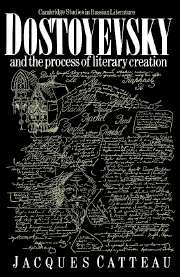Book contents
- Frontmatter
- Contents
- Preface to the English edition
- List of abbreviations
- General editor's note on transliteration and references
- General introduction
- PART I The creative environment
- PART II The process of creation
- Introduction
- 7 The writer at work
- 8 The great dialogue: the news item
- 9 The great dialogue: migrant images
- 10 The play of dialogue
- 11 The unity of thought in the novel
- 12 The summit of creative interrogation: ‘The Life of a Great Sinner’
- 13 A Raw Youth: reasons for choice
- 14 A Raw Youth: the appearance of the vision
- 15 A Raw Youth: the human architecture
- 16 A Raw Youth: the Idea of the novel
- 17 The composition of the novel in Dostoyevsky's work: choice of chronicle form
- 18 Composition of the novel in A Raw Youth: chronicle and stories
- Part III Time and space in the world of the novels
- Conclusion
- Notes
- Select bibliography
- Index of names
18 - Composition of the novel in A Raw Youth: chronicle and stories
Published online by Cambridge University Press: 18 December 2009
- Frontmatter
- Contents
- Preface to the English edition
- List of abbreviations
- General editor's note on transliteration and references
- General introduction
- PART I The creative environment
- PART II The process of creation
- Introduction
- 7 The writer at work
- 8 The great dialogue: the news item
- 9 The great dialogue: migrant images
- 10 The play of dialogue
- 11 The unity of thought in the novel
- 12 The summit of creative interrogation: ‘The Life of a Great Sinner’
- 13 A Raw Youth: reasons for choice
- 14 A Raw Youth: the appearance of the vision
- 15 A Raw Youth: the human architecture
- 16 A Raw Youth: the Idea of the novel
- 17 The composition of the novel in Dostoyevsky's work: choice of chronicle form
- 18 Composition of the novel in A Raw Youth: chronicle and stories
- Part III Time and space in the world of the novels
- Conclusion
- Notes
- Select bibliography
- Index of names
Summary
The tone and manner of telling the story are said to occur to the artist naturally. This is true, but sometimes you lose your way and have to look for them.
F. M. Dostoyevsky, Letter to N. Strakhov, 9/21 October 1870Research ends and writing begins
The novelist's research ended when he had defined the narrative form and chosen the narrator, in short, with the selection of a definite form of composition. The natural antinomy between thought and writing had been resolved: it was an end and a beginning.
It was an end, because this choice was made only after the appearance of totality, only after the idea of the novel had crystallised and been passionately tested by experiment, only after the ideal structure of the Dostoyevskian novel, with its explosion, dispersal and spatial development, reflecting the ‘broad nature’, and its rending of the human architecture, had been set in place, only after the main hero had been selected. The decision about composition did not mean that everything had been decided; on the contrary, the testing of the Idea of the novel by its final gestures and the precise distribution of secondary characters went on after the writing had begun. In the notebooks of A Raw Youth, Prince Sergey Sokolsky is a typical case; the first chapters had already been written, but Dostoyevsky still did not know the nature of his love affairs with the beautiful Akhmakova, the gentle Liza or the intriguer Anna Andreyevna, how he was going to die (suicide? madness?) or whether he was going to be a political spy.
- Type
- Chapter
- Information
- Dostoyevsky and the Process of Literary Creation , pp. 315 - 326Publisher: Cambridge University PressPrint publication year: 1989



